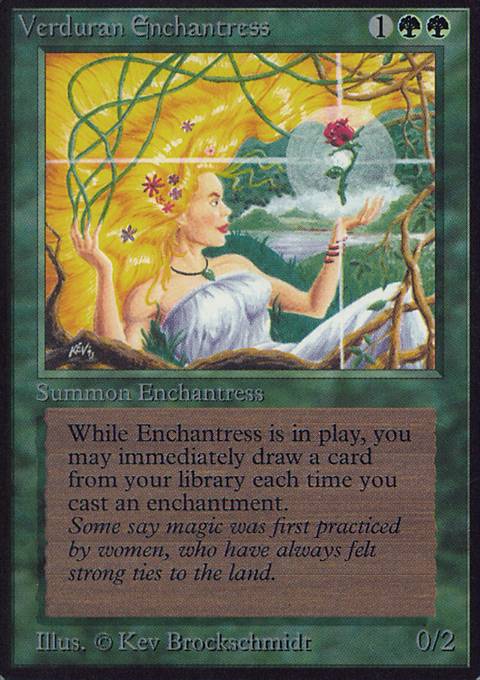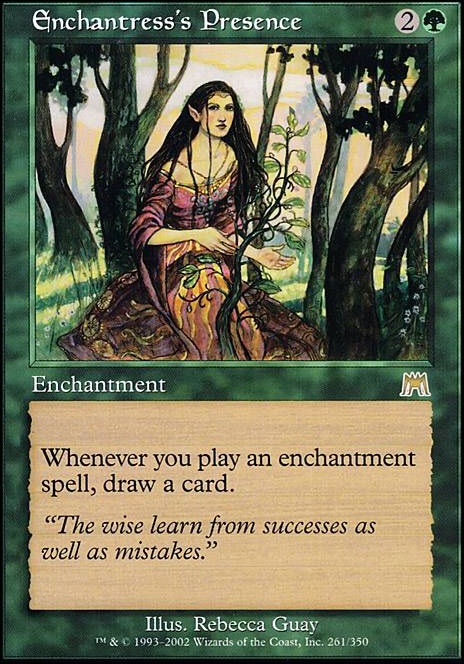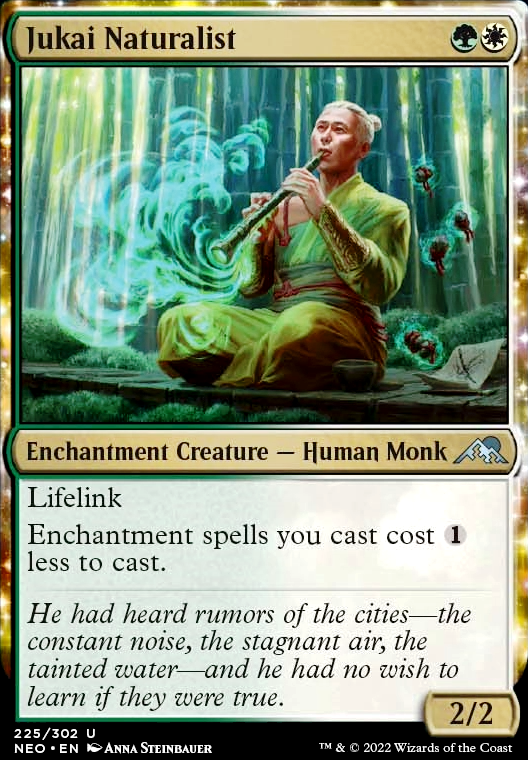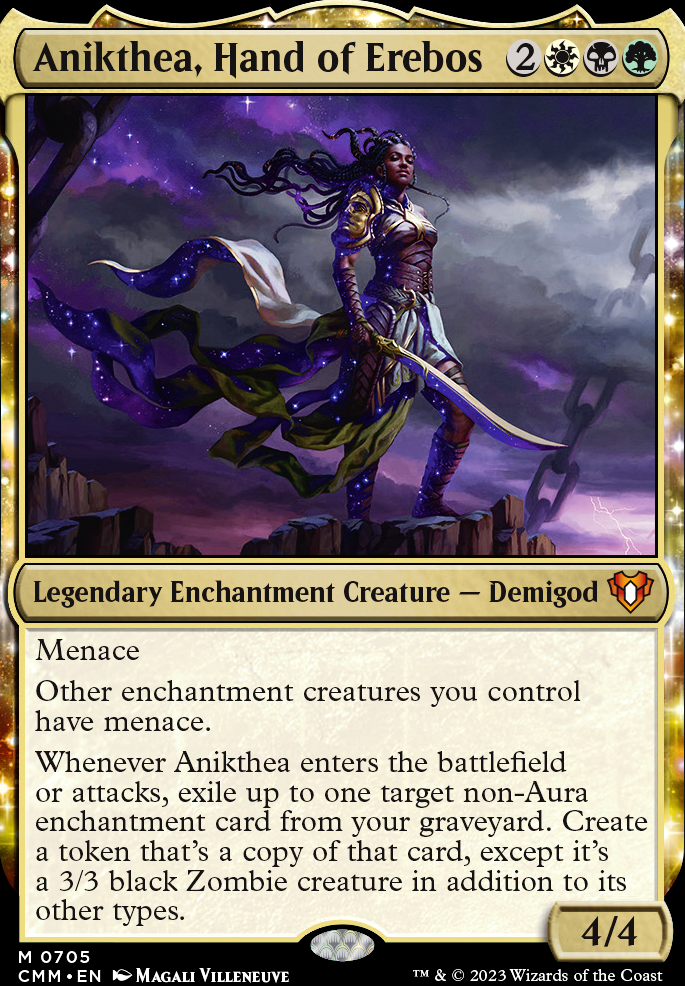Pattern Recognition #296 - Enchanté
Features Opinion Pattern Recognition
berryjon
7 September 2023
361 views
7 September 2023
361 views
Good day everyone! My name is berryjon, and I welcome you all to Pattern Recognition, TappedOut's longest running article series. I am something of an Old Fogey and a definite Smart Ass, and I have been around the block quite a few times. My experience is quite broad and deep, and so I use this series to try and bring some of that to you. Be it deck design, card construction, mechanics or in-universe characters and the history of the game. Or whatever happens to catch my attention each week. Which happens far more often than I care to admit. Please, feel free to talk about my subject matter in the comments at the bottom of the page, add suggestions or just plain correct me.
And welcome back! Today, I'm going to try to be relevant, and talk about something that came up in the recent Commander product this past summer, but has been around for quite some time. Today, I'm going to talk about the Enchantress Deck Archetype.
So, let's go back in time, to the early days of Alpha. Buried in the midst of such titans of gameplay like Craw Wurm and Prodigal Sorcerer was a curious little utility card that didn't seem like much. It wasn't a card that made waves at the start of the game, it didn't win games, and it seems little more than a utility creature on the way to bigger and better things.
Oh, how they were wrong.

The Verduran Enchantress game into the game with very little to really show for it. Well, no, that's not really true. It does require a bit of context. In Alpha, there are, or were, 12 different Enchantments. Of them, I would say that Lure, Wild Growth and Fastbond are the ones that people most remember. With Aspect of Wolf being supplanted by Blanchwood Armor at some point. had a lot of Enchantments in this first set, thanks to getting five coloured Wards, like Green Ward and five Circles, Circle of Protection: Blue for example. What we saw here was a creature that rewarded you for playing these other cards, but didn't do much themselves - it was, to be frank, quite easy to remove them from the battlefield so long as there weren't more pressing targets that needed killing in the current board state, or the near future.
This is not to say that the Enchantress was bad, far from it. It was just very much a passive utility creature in a style of game that didn't really reward that sort of play.
Now, before you all jump down my throat for that comment, consider that I am speaking in the realm of this being just Alpha. Things were weird back then! However, this was actually the case for quite some time, for a couple years, at least. The Enchantress wasn't a top-tier card, but it did find a home in Enchantment-centric decks, which leads me to the next point.
Why build Enchantment Decks in the first place?
Well, there are a couple reasons for that. First, and perhaps the most important one that I remember from digging through my 20+ year old memories, was in the non-interaction. Back then, and even today, Enchantment removal wasn't something that people really packed into their decks en-mass. They weren't willing to run Tranquility as much as Disenchant. That, and more importantly...
THREE FIFTHS OF THE COLOURS COULDN'T DO A DAMNED THING ABOUT IT
Yes, that deserves an all-caps, and you can't blame me for it. and 's only response to an enchantment on the table was to grit their teeth and try to plow through, taking out the player before things got out of hand. had their traditional standbys of Counterspell and Boomerang to try and deal with them, but a lot of the Enchantments were passive, so how could you tell what was a real threat or not?
Well, OK, there were ways, but this was also a day and age when didn't have a bottomless supply of counterspells and card draw, and actually needed to be picky about what threats to send to the graveyard instead of allowing to the Battlefield. Threat assessment was key.
Which left and , and well, they are the ones who can deal with Enchantments with ease from the start of the game all the way through to the modern day.
So there is that; a lot of decks and colors simply couldn't deal with Enchantments, a deliberate decision in the design of the colour pie as each colour was supposed to have limitations about what they could or could not deal with. Green couldn't deal with creatures unless it was through combat. White couldn't counterspell like can, so it could lose the initiative pretty fast. couldn't address artifacts, and had restrictions as well. It was an attempt at balancing the various colours against the various ways to play the game, and, well, it was an attempt, at least.
The second thing about proto-Enchantress decks was that while one or two Enchantments had some utility, as you started to add more and more, they became more and more comprehensive in what they did. I've run the Deck of Protection, which ran all the Circles, and a handful of Angels to win while sitting behind my comprehensive "You can't Touch Me!" protections.
Yes, I was an ass back then. Still am!
Anyway, the Enchantress was kept in these decks because she provided something that other cards in the archetype really couldn't - card draw. These two colours had problems with it, and the Enchantress provided much needed fuel for further spell casting. And if you had multiple Enchantresses in play? Well, that was even better!
Of course, Wizards did notice this, and in Urza's Saga (the block, not just the set), we got a couple of interesting cards to go along with the Enchantment/Artifact theme of the block. Because yes, Urza's actually tried to help Enchantments along as well as the more (in)famous Artifacts. Yavimaya Enchantress was a creature that got larger the more Enchantments you had in play, and Argothian Enchantress downshifted the mana value by , lowered the Toughness, and added Shroud to make her even harder to remove.
Of course, all these creatures (including the Femeref Enchantress, which looked at Enchantments going into the graveyard) had the same name, the name which then became synonymous with the archetype as it developed and grew. These were all Enchantress Decks. Because why let a good thing get away from you when you can embrace the theme?
At this point, around the Invasion Block, the idea of the Enchantress deck became more firmly entrenched in game design, and cards started to be designed with it in mind. Aura Shards is a card that has seen a lot of play - that could just be my local biases and meta showing - for being able to turn any creature into a Nature's Chant, and it's counterplay (or temporary hiccup) in Sterling Grove.
I think these two cards really turned the corner on what it meant to be an Enchantress deck, because here were cards designed to be included in them, or in response to them. There was a dedication to the concept that started to appear here that hadn't before.
So someone turned around and asked, "Hey, does our Enchantress have to be a creature? What if she was an Enchantment herself?"

Yeah. Also, Rebecca Guay continues to be a beautiful artist, and deserves all the praise we can give her.
But here Enchantress ran into a problem. It was drawing cards, it was playing spells, but... how was it winning? You could avoid losing if you played your cards right, but actually winning became something of an issue, and here, Enchantress decks blossomed outwards into varying ways of winning. In the same Blocks as the above Enchantress's Presence, we have Test of Endurance, which was a passive means of winning the game, as Enchantments with lifegain - Planeswalker's Mirth for example could be played. It was difficult, and oftentimes, the decks became 'Enchantress to Find the Win, then Combo Out'. Which wasn't wrong, but it seemed to defy the expectations of the theme. I mean, if you want to Draw To Combo, play .
And so Enchantress decks sort of ... languished here. As a Selesnya Enabler, something to run to get to the real good stuff. Sure, there were ways to close out the game, but as a general rule of thumb, Enchantress just wasn't top tier, but one of those decks you always had to keep in the back of your mind, just in case.
Then it all changed. Then, something was published to the players, something that Wizards had designed to make Enchantress so much better than it could have ever been.
Theros happened
Theros was a set designed to be an Enchantments Matter block, and to that end, Enchantress decks got a huge shot in the arm. From Eidolon of Blossoms, a traditional Enchantress that was also an Enchantment at the same time as being a Creature, to the Contellation Mechanic, which rewarded you for playing Enchantments in other ways, like Setessan Champion, the ability of an Enchantress Deck to close out the game now was most firmly within their grasp. No longer did they have to stall the game state out to win, they could pull out a win on their own accord! All was great!
Theros represented both a groundswell and a paradigm shift in the way Enchantress was approached. No longer was it what I have described before, it had become something of a midrange deck. Yes, I know I'm glossing over a lot of facts here, but bear with me. Enchantress was here to stay as more than an also-ran, but there was one more step to take before it really came into its own as a complete archetype on its own, and not just as an enabler for other end-games.
Commander 2018 gave us the last pieces Enchantress wanted in the form of the Tuvasa the Sunlit![]() . Wait, no, sorry, the lead face-Commander on that was actually Estrid, the Masked
. Wait, no, sorry, the lead face-Commander on that was actually Estrid, the Masked![]() , and while the latter is an excellent Enchantment Commander, Tuvasa was the better Enchantress Commander thanks to being one themself. They draw cards (once per turn), and have the same benefit as the Yavimaya Enchantress from ages past. In addition, this Commander added to the available card pool, and that colour really does have plenty of things to add, that's for sure.
, and while the latter is an excellent Enchantment Commander, Tuvasa was the better Enchantress Commander thanks to being one themself. They draw cards (once per turn), and have the same benefit as the Yavimaya Enchantress from ages past. In addition, this Commander added to the available card pool, and that colour really does have plenty of things to add, that's for sure.
These two definitely made Enchantress a lot more viable and more importantly, visible to a lot of newer players - and I can't believe I'm referring to people in 2018 as new. But with this visibility not raising awareness of what Enchantress was and could do, the archetype kept receiving a constant, though not always obvious flow of cards to help improve or optimize it. I mean, what else would you call All That Glitters? Or Sythis, Harvest's Hand At this point, it would be ridiculous to list all the good cards that came out, so I'm going to skip ahead to Kamigawa: Neon Dynasty. In that particular set, we got a return of many fan favourites form many sets past and present, but the most important part was the of this glorious card:

This absolutely amazing card just does so much! This Signpost card not only is an Enchantment Creature itself, checking two boxes for the price of one, it's only 2 mana, has lifelink, and lastly, it reduces the cost of all other Enchantments you cast. This card is a vital centerpiece in Standard Enchantress. Yes, that's a thing. Because of Kamigawa, and the lack of a Rotation this year, if you hopped onto Arena right now and started playing Standard matches, after three, I'm willing to bet you will have played one such deck. It's that ubiquitous, and goes to show that a good archetype can appear in multiple formats, and be recognizable and viable in each.
But what brought me to here was the latest offering to Enchantress decks.

Anikthea is the face-Commander of one of the four Commander Masters Precons that came out this past summer. The deck was a surprise hit as most players were expecting the Slivers and Eldrazi decks to rock, and the price went up accordingly. Instead, this deck combined the positive reinforcement of a semi-well designed Enchantress deck, and added in 's game ending shenanigans to taste. I'm worried about facing them in the next Slow Grow Tournament, that's for sure.
Enchantress is an archetype that has been slowly growing over time, but its growth and power creep has been inexorable. From Alpha to Wilds, cards and abilities have brought it from secondary utility to fully grown power player in some formats.
And this is good!
Without Enchantress, would be stuck as the colour pairing of Creature Combat, whose unified section of the color pie is Creatures, Creatures, More Creatures, and then Make Them Big and Swing At Face. And that's boring. Having options is good, and Enchantress provides it.
It also keeps Enchantments their own unique identity, keeping it away from people who think that Artifacts should have been a subset of Enchantments. I mean, what am I running here, Sram, Senior Edificer? Yes? No?
I love this archetype, though it's not in my normal wheelhouse. I really should give it a proper shot. I want a Harvest Hand, but I do have Tuvasa, so perhaps I'll roll that out. I'm not really sure yet. Or I'll go see about building my own version on Arena for Standard and something different than my RDW Deck.
It's fun! And if you haven't tried it, I think you should as well. Expand your horizons!
Thank you for reading. Join me next week when I talk about something new and/or different. I'm not sure yet.
Until then please consider donating to my Pattern Recognition Patreon. Yeah, I have a job, but more income is always better. I still have plans to do a audio Pattern Recognition at some point, or perhaps a Twitch stream. And you can bribe your way to the front of the line to have your questions, comments and observations answered!
Gidgetimer says... #1
I feel like you skipped over a whole slew of the development of Enchantress as an archetype and therefore presented it as being a deck in search of a win con before Theros. It has always been tier 2 jank in legacy, but it was powerful enough to take occasional large tournament wins.
You mentioned Urza's block and mention the two cards with "Enchantress" in their name but not Serra's Sanctum or Replenish. The latter two actually make it into competitive eternal decks and Yavimaya Enchantress does not.
The Sanctum in particular is extremely important to the way the deck developed. The plan in many eternal enchantress decks is legitimately to hardcast Emrakul, the Aeons Torn. This still takes until turn 5 or 6 and is durdly as hell for the format, but all that mana from the Sanctum makes it a legitimate plan. Alternatively the win condition in many others is to plop down a Sigil of the Empty Throne and go wide with 4/4 angels. I even have a friend who ran Words of War as a wincon, again greatly aided by the Sanctum.
The "dig to the combo" you mention that is actually played is Helm/RIP and is the third commonly played wincon. And I'm not sure I agree with the assessment that it defies expectations, or should be abandoned in favor of playing blue. At its heart Enchantress as an archetype is GWx control and the wincon can be almost anything.
Wincons from Theros were never even added to eternal Enchantress, they kept the old wincons and added at most a few Eidolon of Blossoms and a few Doomwake Giant. The return to Theros did give us Destiny Spinner who is a wincon that is run. MH2 also had a large impact on eternal Enchantress by adding Sythis, Harvest's Hand and Sanctum Weaver.
This isn't to say that there haven't been strong enchantments coming out recently. Or that it isn't nice that they are supporting the archetype to an extent that a standard deck can be made out of it. It is just that if one wants to talk about the evolution of the archetype it should be done primarily in the context of competitive eternal formats where it will remain unchanged until a card changes the archetype. With mentions of rotating and casual formats to show the archetype across the whole of Magic.
September 7, 2023 7:51 p.m.